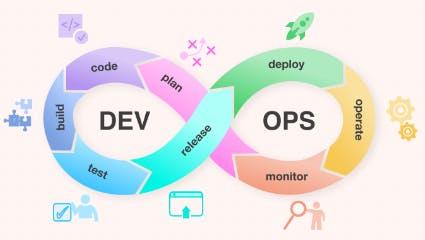The concept of DevOps is gaining immense popularity in the software industry. It's all about being super fast and automated. Everyone is jumping on the bandwagon, ditching the old ways of developing and deploying software.
And let's be honest, one of the main reasons DevOps is so hot right now is that it comes with a boatload of job opportunities. But here's the thing: the people who came up with this idea didn't intend for it to be some fancy exclusive role. They wanted everyone involved, from the developers to the operations team, to be a part of the DevOps revolution.
The WHY of DevOps
It is important to understand the need for the entire shift from an already proven method of software development. In the traditional way, the developers' team would code new features and fix bugs, then ask the operations team to deploy the application based on some documentation.
Both teams want to provide top-notch code for end users, but their immediate motivations may be a bit different. Developers want to constantly upgrade applications by coding new features, while the operations team wants to keep the application stable and accessible on the servers.
Because of this disconnection, there was a figurative barrier separating these two squads, resulting in utter bewilderment and an excruciatingly sluggish release process. We desperately required a radical change from a snail-paced, laborious, and mistake-riddled system to a fully automated, rapid, and trustworthy method.
The DevOps philosophy aims to eliminate bottlenecks from the entire process and relies on continuous improvement in each iteration of the development cycle.
What's in a name
DevOps is like a hilarious mix of cool philosophies, practices, and tools. It's all about speedily handing over the most awesome code to those end users. But wait, that's just a basic way to explain it.
DevOps is like this super-duper ideology that uses its fancy tools and technologies to get things done. And hey, each step in the whole process should totally use these tools to make the final outcome totally mind-blowing!
The DevOps lifecycle

The infinity symbol is a fitting logo for DevOps because it represents the core principles of the practice. DevOps is about continuous improvement, collaboration, and never-ending change. The infinity symbol captures all of these principles in a single image. It means that DevOps can be used for endless possibilities achieved through it.
Continuous Integration, Continuous Deployment, and Continuous Delivery are the three main phases of the software release pipeline.
Continuous Integration
Imagine a small group of software developers toiling away at a web app, each one working alone on their own computer. When it came time to release the app, a dedicated person - usually the sysadmin - had to collect all the code and try to mash it all together. As you might imagine, this went about as well as you'd expect: total merge hell! The devs were isolated and had no idea what changes others were making until the very end. Talk about a lack of communication! Plus, there was a whole lot of waiting and delays before anything could be released. Yikes!
With a limited scope of testing, without a systematic approach, bugs and issues would often go unnoticed until the release phase. This led to poor software quality and customer dissatisfaction.
But fear not, my friends! With Continuous Integration tools, we can catch those pesky bugs and issues before they make us look bad. These tools even give us a heads-up when tests fail, saving us precious time. Every time code is committed, it will be built and tested before integrating it into the final product. This bit-by-bit merge is the essence of Continuous Integration.
We can thank DevOps tools like Git and Jenkins for helping us reach our goal of awesomeness.
Continuous Deployment and Delivery
Continuous delivery, a fancy upgrade from continuous integration, automatically launches all code changes to a testing and production setting after the build stage. This means you can now release your application by simply clicking a button.
Continuous deployment, on the other hand, takes things up a notch. Every progress that passes all stages of your production line is released to customers without human intervention. Only failed tests can stop a new change from going live. Thanks to DevOps tools like Kubernetes, developers can focus on software building and see their work hit the market in minutes.
Infrastructure as Code
Okay, so when the big shots on the team start getting ready to put their apps out there, they might use servers from their own stash or rent some from the cloud dudes. Either way, it's gonna take forever and there's tons of room for mistakes. But hold up, here comes the cavalry! DevOps to the rescue with the IaC tool called Terraform. With this bad boy, they can create and tweak their infrastructure in a jiffy, no screw-ups allowed. It's legit, saves time, and works with any cloud provider. Best part? They can even roll back to previous setups with ease. Who needs a crystal ball when you've got Terraform?
Setting up the infrastructure is just the beginning of the never-ending cycle of updates, backups, and other configuration tasks. In the olden days, the admin would have to run manual scripts on their servers like a medieval scribe. This included updating Docker, rebooting systems, and creating users or groups. But fear not! Ansible is here to save the day. It's agentless and just like magic, no need to install anything on your machine, just give it the IP address and watch it carry out all your monotonous tasks like a piece of cake.
Monitoring and Observability
So, you’ve got a whole bunch of servers and they need constant monitoring because when they crash it’s like finding a needle in a haystack. The user interface of the applications isn’t much help either. But don’t worry, Prometheus is here to save the day! This tool monitors all the services and alerts the admins if there’s a problem. Say you’ve got a server with too much stuff on it, Prometheus will let you know when it hits 70% capacity so you can fix it before it crashes. It even stores the data and lets you query it with PromQL. And if you want to do data visualization, Grafana has got you covered with some fancy dashboards. How cool is that?
Conclusion
So, my dear friends, let me tell you, the DevOps revolution is not a joke! Think of it as having your own cheerleading squad for software delivery. With the DevOps ideology and its fancy tools, you'll zip through your projects faster than a squirrel on a sugar high. Say goodbye to endless code conflicts and hello to a harmonious collaboration. Get ready to join the DevOps party, 'cause we're about to revolutionize software delivery! Let's get high-fives, agility, and even some confetti cannons because, with DevOps, the sky is the limit!
